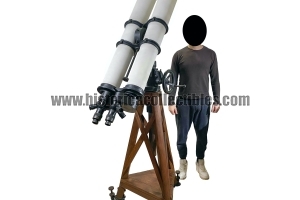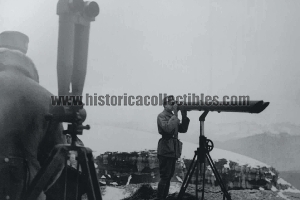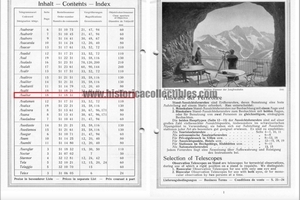Doppelfernrohr "ASALTUR" with Wooden Case - Carl Zeiss - 33x 52x 72x 110 mm, about 1915
Doppelfernrohr or Double Telescope Revolver "ASALTUR" made by Carl Zeiss Jena around 1915.
This extraordinary Double Telescope called "ASALTUR" consists of two tubes with a length of 150 cm on which are placed two groups of inversion prisms with two triocular revolver turrets of 33x, 52x and 72x, objective lenses of 110 mm for a focal length of 130 cm.
The Telescope is complete with its pyramid-shaped wooden tripod, connected to it by a manual rack-and-pinion elevator device which allows the observer to acquire the height most suited to his use. A 360° rotatable single fork steel element binds the Telescope to the elevator device.
Given the considerable weight of the Telescope, its zenith movement is regulated by a manual mechanical clutch placed on it. Besides, among its great peculiarities, this Doppelfernrohr allows terrestrial or astronomical observation to two people at the same time. In fact, its extraordinary optical groups that by rotating 180°, allow to obtain the necessary space between the eyepieces for this specific monocular use.
The production of this specific model of Telescope was limited to very few examples and, as reported on the descriptive document of one of these exhibited at the State Museum of the city of Columbia in South Carolina (USA) in 1933 had a cost of $ 1428.00, corresponding to the purchase price for a medium-sized apartment. This allowed only wealthy people of the time to get hold of it.
The terrestrial or astronomical vision through all the magnifications available on this Telescope, after more than a century from its design, is simply impressive. The Telescope is in excellent condition, complete with its pivoting wheeled tripod with ground screw locking system, all in absolutely perfect working condition.
Carl Zeiss takes its name from its founder, Carl Zeiss, who on November 17, 1846 chose the small city of Jena, in Thuringia, as the location for his precision optical equipment factory. Thanks to the strict quality control that Carl Zeiss imposed on its products, going so far as to personally destroy the microscopes that did not pass the tests, the newborn Zeiss became the official supplier of the University of Jena and received the gold medal of the industrial exhibition in 1861 of Thuringia as the best research instrument manufactured in Germany, awarded to the microscope Stand I of 1857.
In 1866, the thousandth microscope was produced and the Zeiss name became known in all European scientific circles. Thanks to the studies on the Porro prism, in 1893 Abbe patented a double prism binoculars, which accentuated the perception of depth.
The mass production of Zeiss binoculars began in 1894, already at the beginning of the twentieth century more than 30,000 were made, by the beginning of the First World War the figure had risen to 500,000 and, by the end of the Second World War, 2,260,000 were produced binoculars for the civilian and military market. Models were made starting from 4x11 mm to 12x40 mm, up to real giants such as 80 mm and 100 mm.
Thanks to studies conducted on the perception of light in low light situations, it was shown that the average dilation of the pupil in an adult is about 7 mm. For this reason, the 7x50 mm model was introduced in 1910 and remained on the market until 1917 with few changes to the materials used.
In 1926, following the post-war crisis of the First World War with the Treaty of Versailles which bankrupted many important German companies, Zeiss bought the "C.P. GOERZ" and founded the Zeiss Ikon in 1926.
In 1937, Zeiss had commercial contacts and factories spread over 29 countries around the world. From 1933 Zeiss acquired interest from the Nazi regime, which balanced production towards military instruments. It successfully produced binoculars with wide-angle optics for military use, pressure resistant optical systems for U-boats, periscope binoculars for targeting tanks. Furthermore Zeiss cameras were mounted on the V2 for remote sensing operations of the English coasts.
On November 1, 1935, Zeiss, in the person of Alexander Smakula, patented a process for the treatment of optical glasses with extraordinary results in terms of light transmission. Remained a military secret until 1939, it was adopted on binoculars to reduce ghost images and internal reflections. During the Second World War, there were numerous bombings against the Zeiss factories.
Jena was bombed several times by the Allies starting in 1944. Stuttgart was razed to the ground, although the Contessa-Nettel factory suffered little damage. The bombing of Dresden, in addition to devastating the city, also caused considerable damage to the Zeiss Ikon headquarters.
On April 13, 1945, American military forces entered Jena, surprising themselves as the bombings had not caused significant damage. The main planetarium was in ruins, while the factories remained operational.





